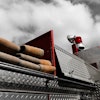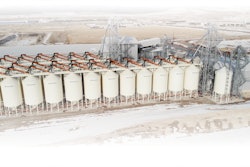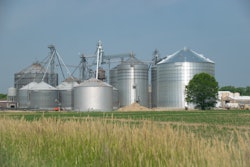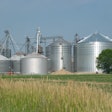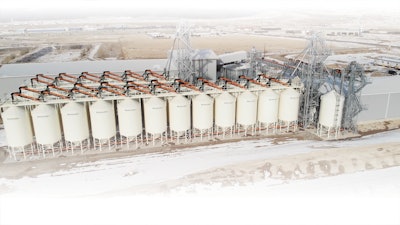
In this episode of theFeed & Grain Podcast, hostSteven Kilgerinterviews Doug McDowall, owner ofSoulCraft, a construction company in Meridian, Idaho, about a unique malting facility they built for Montana Craft Malt.
The conversation delves into the challenges they faced during construction, the innovative grain handling system they designed, and the collaboration with Chief Industries and Meridian Manufacturing.
Doug股票在养活他的专长,种子,fertilizer industry and how SoulCraft's approach to the project focused on cost-effectiveness and user-friendly design. Don't miss this insightful discussion on one of the most interesting facilities Feed & Grain has ever covered.
To read the original feature article,A Hometown Vision,click here.
Steven Kilger:Hello everyone. Welcome to theFeed & Grain Podcast, and thank you for listening. My name is Steven Kilger, managing editor for Feed & Grain and your host.
We've got a different show for you today. This recording is actually one of my favorite interviews I’ve ever done. I’m talking to Doug McDowall, owner ofSoulCraftat a construction company out of Meridian, Idaho, about a unique malting facility they built forMontana Craft Malt. A criminally small amount of this interview made it into the article I wrote, so I figured it would be a great time to dust it off and dive back into one of the most interesting facilities I’ve ever covered.
Before we get into the conversation, if you’re listening to this in a podcast app, subscribe and leave us a review if able. If you’re listening to this online, make sure you’re subscribed to our newsletter industry watch for the latest episodes.
Thank you again for listening! Now, onto the conversation with Doug.
Kilger:So, I talked to the people at Montana Craft Malting about a week ago, little more than that now. While they gave me a lot of information about malting and the company and all that stuff, they were a little light on the actual details of the facility, especially the grain handling part, which is something. We are a grain handling feed manufacturing magazine, so we kind of got to cover that part. I was hoping you would be able to give me some more information on that. But to start, why don't you tell me a little more about the company?
Doug McDowall:I've been dealing in the feed, seed and fertilizer industry for 36 years now and SoulCraft's been around since March 3rd of 2017. I had another company previously, I've been in this business for quite some time. I grew up farming and ranching, so I had a good background on what we do here and I fell in love with the grain handling and processing facilities. So SoulCraft, basically that's what it was designed as, was something we could go in and service the Northwest in the feed, seed and fertilizer industry.
We also have an equipment sales division, which we handle a lot of the majority of Chief Industries and everybody pretty well got thrown on the site there but Chief's been very, very good to me over the years and they're a good company to work with. We've also got a machine shop, which is a roll corrugate shop, that we handle re corrugating and sales of new feed rolls and also, into the flour industry. We deal quite a bit across the Western US. We're looking to get into the Midwest and the Eastern portion of the US, as far as all of our rural corrugating facilities and stuff. We're diversified, but we're still pretty well tied up in the AG industry.
Kilger:Yeah. That's very cool. Why don't you go into how you got connected with Montana Craft Malting and go over the job with me?
McDowall:Well to start off with, Chief Industries was involved in the preliminary part of this. They had a engineering firm, Chief didn't. Montana Craft, Ron Ueland had a engineering firm out of Canada design the first go around. It came in, Chief contacted me, asked me if I was able to handle this and I told them, "Yes, I'd be very interested in it." And so, we went through and bid it the way that they had it designed originally. And they weren't very versed at grain handling.
It came in extremely high. And so, I reached back out with Chief's blessing. I reached back out to Ron and let him know there's other ways to do this. I really like looking and working outside the box. If we do the same thing that everybody in this industry does day in and day out, we're going to get the same result.
So, I like looking outside the box and still achieve the end goal but be able to do it a little different then everybody else. And so, that's what has made us successful is by doing those things. I had reached out to Ron and asked him if I could present a different way of doing this that would save him a lot of money. And obviously, he was very open to that.
Kilger:I'm sure.
McDowall:So, with utilizingChief Industriesfor their elevators and towers, catwalks and superstructures, we went through and did that but I also introducedMerdian Mfg., because we had to set it up on basically the same lines as a seed facility so that we could have total clean out. There was no contamination. There's no cross contamination. They were getting exactly what they were putting in, was coming out the other end.
So that's why I designed this to look more like a seed facility because that's what we had to achieve. After I'd met with Ron and everything on that, he was very open to it. And he introduced me to a gentleman by the name of Jason Myers, super good guy. He's been with ADM, everything else. He and I basically worked together and were the liaisons to Ron.
We basically designed on-the-fly, all of that system, that grain handling system up to the malt plant. And then we took it from the kiln and brought it out from there. But for the most part, Ron had enough vision and understanding in the grain industry that he understood that what we were proposing would definitely fit his budget and it would get them in there.
我们不得不做一些漂亮的供需关系紧张的预算ints and that's how it is. I mean, nobody gets an open checkbook on these things. But I tried to give them the very best we could with that budget in mind. I didn't ever know what that number was. If I was a little high, Ron would let me know that day or Jason. Either one would let me know, we've got to chop this much out. So, there's a lot of stuff. If you went in and really critiqued that facility, it may not be up to par as far as what today's standards are. But there's things that we can add in as they grow and they move because we had to get it off the ground and that's what we ended up doing.
Steven:Yeah. Well, part of the thing is, we really want to start focusing on unique, not as large ... Not everyone can spend $30 million on a new feed mill or whatever. Our industry has room for all levels of players.
McDowall:完全正确。这并不是我们不能设计3美元0 million facility but for the most part, we want to give them the best bang for their buck. I mean, yeah, the first design would've been awesome but it wasn't very logical. So, that's where we've got to use some logic in this thing to be able to get what they want and get a longterm facility, something that's easily maintained. That's what we like looking into, is being able to maintain these because that's a part of our business that we do but I don't want to give them something that they have to work on every day. I want it to have a little bit of industrial strength to it.
Kilger:Excellent. So they told me a little bit, you guys seemed to have some trouble during construction. I mean, it happens to every project but I hear you guys got hit with some weather and all kinds of issues. So, you might go into the construction process with me?
McDowall:No, actually it really wasn't that bad on our part of it. We did get in into it when we started out that year. We got in there and we got the tanks set, but yeah, winter in Butte can be a little interesting, you know? I've dealt with winters like that before but it does, it brings different aspects to your project. It slows it up a little bit but all in all, we were ahead of the eight ball going into the deal. Obviously when Ron died, things really shifted gears and we had to readjust. And then by the time we got back in than we ended up being on the same timeline as everybody else at that point. But basically, they never did wait on us for any of that project.
But as far as troubles and stuff like that, most of it's going to be weather, timing with other portions of that. Like the, oh shoot, the malting building itself, the items in the malting building, basically there was a lot of that that they had issues with come from China and there were just different aspects that we had really throttled back and then jumped back into. But I think that they did a very good job of handling all of that, working through it. We was able to provide through Chief, the superstructures that they needed inside that building that China didn't provide.
Chief jumped in, we handled putting all that in there for them and it was kind of a retrofit but it worked. I mean, we were able to make it work for them. And that's really where the timeline came in there, was trying to get something designed to fit what they had to have in there because of the vessels and everything that was already designed. We had to do a reverse engineering to get back in there on that side of it. So there was some, I guess, trying moments on that portion of it. But as far as the rest of the grain handling, it was pretty day to day.
Kilger: Normally how I like to go, as I write an article, is from when grain comes in till the final product comes out. So, there's that big chunk in the middle that's their side of it. It's just malting tanks and all that stuff. I had to learn about malting because I had no idea how any of it worked. So, they get most of their grain through trucks. So, what happens when a truck pulls in?
McDowall: Basically what we did again, we set this thing up on a seed facility basis. What we did is, they didn't want any receiving pits. And so, for a temporary set up we use the backhoe pit stops. It's an above ground drive over belt conveyor we can unload belly dump and/or dump trucks. And so, when it comes in it comes through the receiving leg, into the 14 bin holding structure or the dirty bins. We'll take that product from there and run back up the receiving leg across the conveyor that goes into the malt building. Malting process takes place at that point, we pick it back up at the kiln. We take it from the kiln and then it's already cooling down and it's pretty cool, we'll take it back across, run it through a Kice aspirator to remove all the rootlets and everything.
From there, it goes up into one of the 24-bin storage units, which it will set there up to a month or so. And then we can pull it back out, run it over to one of our surge bins for the bagging. We've got a JEM International System in there, which we can fill totes. We can bag or we can run it out into a bulk truck. Everything is weighed out and gone through there. There's a few processes there that we could add in and we've talked about adding but for the startup, it is what it is, a dollar number. So, basically that is the system in a nutshell.
我们起床上的这些东西,上p of the bins and everything, is with the backhoe conveyors being piggybacked, it allows me to handle that and be able to get that consistency with no cross contamination and everything else. We can go from bin to bin and isolate it. If things changed I would probably, instead of doing that ... That's a little bit of a costly way to do it but it was as per Ron's request that we do it as a seed house. So, if I was to go back in and redo it, it would have Chief conveyors, a chain conveyor up there because they do a better job of handling product and it lasts a lot longer. But that's why I didn't do a Chief conveyor and I did the backhoes because it was the most cost effective way in order to do that for us.
Kilger:Excellent. So each bin gets completely cleaned out, right?
McDowall: Yes.
Kilger:Are they all gravity fed then? Or how does that work then?
McDowall: What we do is, one week, come out of the receiver, it'll run through the backhoe conveyors up on top, fill the bin. When it comes out of the bin, then we hit some backhoe conveyors coming off the bottom that is regulated with a actuator gate at the bottom to where the product will run back through. And whether we're running into the bagging system or we're running into the malting system, all the bins run exactly the same way. It's basically a pretty simple design and a lot of the parts are ... You can use any of the backhoe components on any of them. They're all the same size. Likewise, with the elevators and everything else. We try to keep it to where it was user friendly or maintenance friendly to where you didn't have that miles of ton of parts. You could have a few that would fit anywhere.
Kilger: Well, those are all the questions I have for you. Can you think of anything else you think I should know?
McDowall: I can say, this basically hit. Making sure that Chief Industries, Meridian, Patco all these guys get recognized because they played a huge part in it. They provided top quality equipment for something that turned out very well.
Kilger:All right. I will talk to you soon, Doug.
McDowall:All righty. Thank you, Steven.

.jpg?auto=format%2Ccompress&crop=faces&fit=crop&h=48&q=70&w=48)
